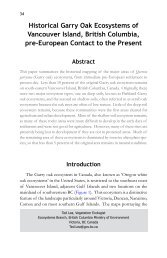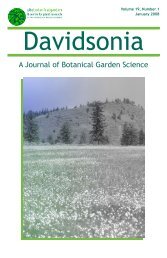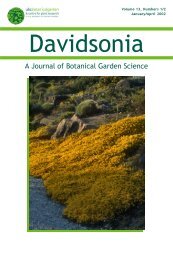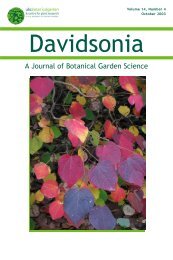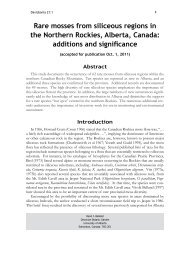in Vancouver, British Columbia, Canada - Davidsonia
in Vancouver, British Columbia, Canada - Davidsonia
in Vancouver, British Columbia, Canada - Davidsonia
Create successful ePaper yourself
Turn your PDF publications into a flip-book with our unique Google optimized e-Paper software.
<strong>Davidsonia</strong> 18:2 63or cordate to cuneate. Leaf size is 10-15 x 5-8 cm (4-6 x 1.9-3.1<strong>in</strong>) onmature flower<strong>in</strong>g specimens, while on vigorous trees on moist sites theleaves often resemble those of Populus, often reach<strong>in</strong>g 24-30 x 6-8cm(9.4-11.8 x 2.3-3.1<strong>in</strong>). The leaf marg<strong>in</strong>s are set with regular, 1mm pegliketeeth and have conspicuous, <strong>in</strong>-rolled flanges. Petiole length rangesfrom 2-5cm (0.8-2<strong>in</strong>) and the petiole curves downwards where it attacheswith the leaf-blade. There is a pair of small glands at the junctionof the leaf blade and petiole. These are p<strong>in</strong>kish <strong>in</strong> color (similar to thevegetative buds) and resemble those found <strong>in</strong> Populus. Leaves fall green<strong>in</strong> the late autumn (November) if weather conditions rema<strong>in</strong> frost-free.We have never recorded any autumn colour.FlowersPlants are remarkably variable with respect to flower<strong>in</strong>g. Dr. Quent<strong>in</strong>Cronk and his students have been study<strong>in</strong>g the phylogeny of Carriereaand the genomics of the Salicaceae, and they have shed some lighton this sexual plasticity. Several genera <strong>in</strong> Flacourtiaceae (a considerablenumber of flacourts are now placed with<strong>in</strong> the Salicaceae, (Cronk, 2005)<strong>in</strong>clud<strong>in</strong>g Carrierea, are functionally dioecious, yet sporadic occurrencesof monecious and hermaphrodite <strong>in</strong>dividuals occur. The fertile seedpodsof hermaphrodite trees are generally located at the term<strong>in</strong>al positionof the panicle. The same morphology occurs <strong>in</strong> the closely relatedgenus Idesia. It is <strong>in</strong>terest<strong>in</strong>g to speculate about the adaptive advantageof this wide range of sexual options. Both monoecy and especiallydioecy <strong>in</strong>hibit <strong>in</strong>breed<strong>in</strong>g (Quent<strong>in</strong> Cronk, pers. comm., 2005), whichcan have negative effects on a species’ long-term viability, but hermaphroditicbehavior may give the plant survival benefits, when geographicisolation, climatic stress or physical disturbances pose powerfulnatural dangers to their cont<strong>in</strong>uance.Individual flowers are borne <strong>in</strong> erect or spread<strong>in</strong>g <strong>in</strong>florescenceson lax term<strong>in</strong>al shoots (Figure 4). The flower masses resemble a candelabra.Wilson described them as “…curiously-shaped, waxy-whiteflowers borne <strong>in</strong> erect panicles” (Wilson, 1913. page 173). The rose-redrachis of the panicles is a most attractive foil for the pale flowers. Upto 10 flowers are produced, each with five heart-shaped, rugose sepals,which functionally replace normal petals. Flower colour varies from



